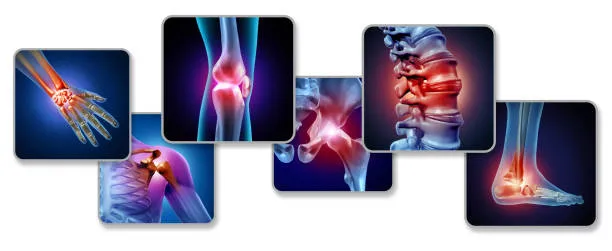The word arthritis means "inflammation of the joints," but it can also refer to other joint diseases.
The inflammation of arthritis can develop due to injury or infection. It is also often inherited.
Joint pain is also a symptom of other diseases such as lupus or fibromyalgia.
There are many different types of arthritis, as well as conditions that doctors consider arthritis because of how they affect your body.
What are the different Types of Arthritis?
There are different types of arthritis and diseases that medical professionals consider arthritis.
Ankylosing Spondylitis: This is a condition that causes erythematous inflammation in the ligaments, tendons generally soft tissues and joints of the spine.
Gout: This condition most commonly affects the big toe but can develop in any joint.
Osteoarthritis or Degenerative Arthritis of joints: This type mostly but not in all cases affects the hips, knees and fingers. Sometimes it is the result of an injury to the joint. It is one of the most common reasons for physical disabilities in older adults. It is the most common form of arthritis in the elderly.
Rheumatoid Arthritis (RA): This is an autoimmune disease that most commonly affects the joints of the hands and feet.
Psoriatic Arthritis: This condition occurs in people with psoriasis a skin disorder and affects the joints, skin, and areas where tissue connects to bone and other soft tissues.
Septic arthritis: It is inflammation of the joints due to infection.
symptoms of arthritis
Common symptoms are:
pain
flushing or reddening of the skin
feeling warm
swelling
joints that may be stiff and difficult to move
Depending on the type of arthritis, other symptoms are often present with arthritis
What are the symptoms of Ankylosing Spondylitis?
Stiffness of joints and mild, moderate or severe pain in the lower back or hips.
Symptoms vary from one persons, individuals to another. Other symptoms that may accompany stiffness and pain are:
pain, stiffness, and swelling in other joints
difficulty breathing if the area around the ribs is affected
blurred vision and eye pain
Fatigue
Decreased appetite
Weight loss
Sin rashes
Abdominal pain
Softening Bowel movements
Symptoms of osteoarthritis
Symptoms specific to osteoarthritis include:
Crunching in the joints
The sound of bone on bone
Small bony bumps at the finger joints
Joint pain
Swelling
Tenderness
Early morning stiffness when getting out of bed
These type of arthritis does not always cause pain.
Symptoms of Rheumatoid Arthritis
RA is an autoimmune disease, which means that the body's immune system attacks healthy cells. Inflammation in the lining of the joint causes damage to the joint. This type of arthritis occurs bilaterally, on both sides of your body.
The most common symptoms of RA usually occur in more than one joint and include:
pain
stiffness
tenderness and swelling
weight loss
fatigue
weakness
Symptoms of Fibromyalgia
Fibromyalgia is not a type of arthritis. However, it often occurs along with various types of arthritis. Some may also confuse fibromyalgia with arthritis as it shares many of the same symptoms.
The fibromyalgia symptoms include:
pain and stiffness throughout the body
fatigue
trouble sleeping
depression and anxiety
trouble remembering, thinking, and concentrating
headaches, including migraines
tingling and numbness in hands or feet
digestive problems
The above shows a summary of gout arthritis
Now to lupus
Symptoms of Lupus
Lupus is not a type of arthritis. However, one of the most common symptoms of lupus is arthralgia, which is joint pain.Because the symptoms of arthralgia and arthritis are similar, many people lump them together.
Symptoms of lupus include:
extreme fatigue
joint pain and swelling
swelling of the hands, feet, or around the eyes
headache
mild fever
skin rashes
swollen lymph nodes
mouth ulcers
sensitivity to light, especially sunlight or fluorescent lights
chest pain on deep breathing
lupus symptoms come and go often. They can also change over time.
Symptoms of Septic Arthritis
Septic arthritis is the result of an infection. Symptoms include:
warmth and limited movement in the joint
looseness in the joint
fast heartbeat
fever
decreased appetite
Causes
genetics
infections
injuries
autoimmune reactions
aging
Risk factors for arthritis include:
family history
age
being overweight or obese
the nature of your work
smoking
reducing the risk of arthritis
There is no way to completely prevent arthritis.
However, you can usually reduce your risk of arthritis by following these tips:
Avoid smoking.
Avoid injury by wearing proper footwear and safe exercise equipment.
Eat healthy.
Maintain a moderate weight.
Exercise regularly.
Practice good sleep hygiene.
Diagnosis
Your doctor might:
ask you questions about your symptoms
perform a physical exam
order X-rays, ultrasounds, or MRI scans
draw blood for tests
blood tests to diagnose arthritis
If your doctor If you suspect your arthritis is due to an infection, you may want to send in synovial fluid from the joint for analysis.
What are the Arthritis Treatments?
Treatment for arthritis depends on the type you have.
Some common treatments of rheumatoid arthritis include:
Oral anti-inflammatory medications
Creams or lotions to relieve pain and swelling
Medications to slow the progression of arthritis
Surgery for severe joint damage, such as reducing joint stiffness and pain
Heat and Cold
Splints and supports for weakened joints
Relaxation therapy
Aids such as:
Exercise
Weight control
Orthotics for affected joints
Treatment of rheumatoid arthritis
Specific treatments for RA include:
Drugs
Surgery to repair or replace the joint ion
Complementary Therapies
Septic Arthritis Treatment
If you have septic arthritis, your doctor will prescribe intravenous antibiotics and joint immobilization.
Your doctor may also need to flush out fluid or do what we call a debridement of joint to clear the infection.
If the infection is the result of a prosthetic joint, it may need to be replaced.
You can reduces chances of being an arthritis candidate through proper and healthy lifestyle modifications, prevention is better than cure, that is if there is one
References/Resources
Reference 1
Reference 2
Reference 3
Reference 4
Reference 5


